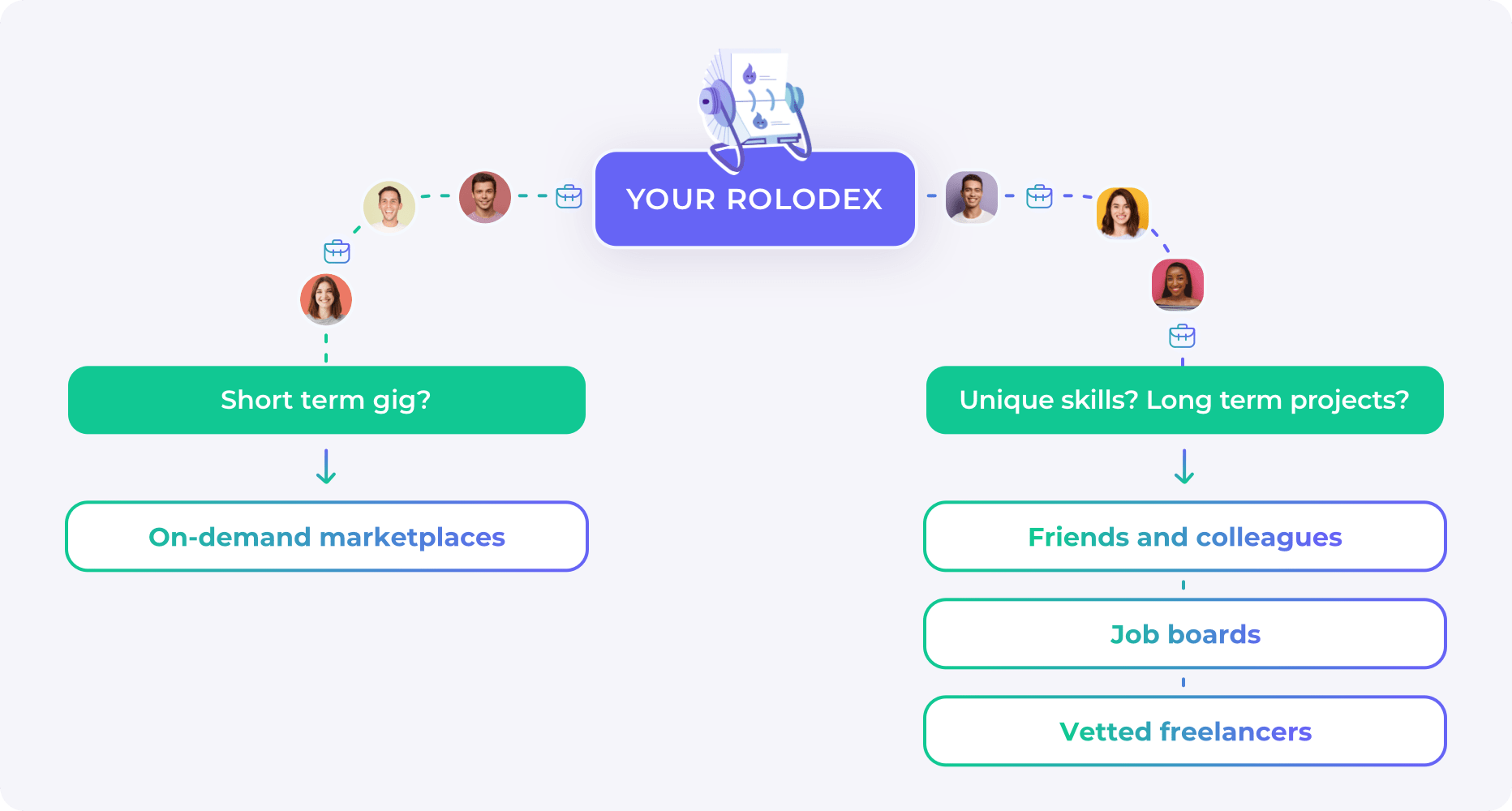Finding and hiring freelancers can be quite a challenge. Especially the kind of freelancers that move the needle for your business and bring valuable knowledge and skills to your company.
Since there are so many types of freelancers and there is no single place to hire them, finding freelancers can be challenging. On marketplaces and job boards, you can find gig-workers, freelancers for short-term assignments, and juniors, but an expert or top talent is normally only found through your network.
The relevant marketplace or job board for you will also vary significantly depending on your industry and the skills you need.
This article will break down everything you need to know, from how to balance in-house employees with independent contractors, to where to look for freelancers, finishing off with 6 great tips for that perfect freelance fit.
Let’s get started!
This is part of a series of articles about Freelance Management.
When should I hire a freelancer?
Companies are increasingly leveraging freelance talent, whether that’s to complete specific tasks and projects, or even to fill certain roles in their teams. However, your first step should always be to work out if a freelancer is even the right choice for this specific need.
To work out if hiring a freelancer is the right way to go, think about the following questions:
1. Are you missing the required level of expertise or skill in-house?
2. Is this a small task, or a series of small tasks?
3. Can this task be completed without deep knowledge of the business?
If your answer to these questions is ‘yes’ x3, this is definitely a job that you could outsource to a freelancer.
Even if only question #1 is a ‘yes’, a freelancer could still be the correct choice. The best thing to do is sit and consider your timeline, and the quality you need for the deliverables, and then work out if you can break the project or the role down into two distinct parts, one which can be taken on in-house, and the other that can be handled by the freelancer.
Let’s say you need a new version of a sales presentation. You need it completed as quickly as possible, and it must be done to the highest standard, but you don’t have someone in-house with experience in building sales decks. You could task an in-house employee with providing the outline story, allowing them to handle the deep business knowledge, and then hire a freelance copywriter and designer who can get top-notch design and wording to you at a quick turnaround.
Remember, as you create relationships with freelancers, you’ll find that they learn more about your business and the way you like to do things, and when the magic happens – they’ll feel like an extension of your team.
However, unlike an employee, you can simply pay for their expertise as and when you need it, and you won’t have many of the costs and overheads, from sick pay or vacation days, to employer and state taxes.
What’s the best way to find a freelancer?
Water, water everywhere, and not a drop to drink!
You would think that with so many workers turning to freelance life, it would be the easiest thing in the world to hire a freelancer. But not all freelancers are created equally. You need to know that the freelancer you’re hiring has the right skills, is reliable, falls within your budget, and will be easy to work with – and if you choose wrong, a project that you need done and dusted quickly could end up taking even longer than if you’d handled it in-house.
Take a look at the flowchart below that can help you recognize where to start the search for the right talent:
We suggest the below flow to understand where to start your search for the talent you need:

The first place to find a freelancer is your own catalogue of contacts, meaning the freelancers who you’ve already worked with in the past. You know their capabilities, and you understand their strengths and weaknesses.
If you’ve checked your handy Rolodesk, and you don’t already know the right talent for the job, then consider the type of skills you’re looking for and your project timeline.
If you need someone to complete a small task for a short term gig or project, a freelance marketplace might be the ideal fit for you. There are almost 800 freelance marketplaces out there that can fit a wide range of needs, anything from niche-specific like PR, SEO, web development, UI, or event management, to local marketplaces focusing on specific regions like India, Germany, Australia etc.
If you’re looking for an expert in their field, then your next steps should be reaching out to friends and colleagues. Referrals are great because you know that the independent contractor has already been tried and tested by someone that you know, who can tell you if their work is good quality, and also if they are easy to get along with.
Colleagues who are working in similar types of companies and roles should be your preferred choice to ask, as their talents will be more relevant, so reach out to some professional groups on LinkedIn, Facebook, Slack or WhatsApp and try your luck.
If you’re active on LinkedIn, you can also try posting your request on your own activity feed, and you should receive a few good responses.
You might also want to think about using job boards. You can find job boards on websites such as LinkedIn and Indeed. Freelancers often need to give a cut of their earnings to freelance marketplaces, or are forced to work through the platform which can add complexity and undue process to the relationship. As a result, you might find that busy freelancers are more likely to respond to job boards rather than marketplaces.
You can also try freelance management systems (FMS) like Fiverr Enterprise, where the platform not only supports you in finding the perfect freelancer, but also in helping you build a talent directory for your own company and keeping visibility and control over a whole freelance workforce moving forward, from hiring and onboarding through to payments and compliance.
Top tips for finding the perfect freelance fit
Now that you know where to look, how do you know what to look for?
It’s a great question. For every freelancer who is going to be an awesome choice for your requirements, there are probably ten more who won’t fit the bill.
Here are our top pieces of advice for hiring managers.
#1: Communicate your needs from the start:
If you know exactly what you’re looking for, there’s no point being vague. You can get two days into a conversation with a UX designer before you realize that they aren’t taking on website projects right now – which is the task you need filled, or that they are fully booked for 3 months straight. Start the conversation with “We’re looking for a freelance designer for our website project – we need it done within 6 weeks, are you available?”
#2 Be clear on budget and terms:
How are you going to pay your freelancer, and do you have a budget in place? Remember that part of being a freelancer means the autonomy to set rates, so ask upfront how much they charge, or explain your budget and ask if it’s a good fit. If they provide their cost per hour – remember to get an understanding of how long the project is likely to take, or sit in the driver’s seat and say “Great, let’s cap the work at 5 hours to start with and see how far we’ve got after that.”
#3 Ask for varied samples:
A freelancer with experience should have samples to spare. Don’t just ask for a single sample, get a mix of different types of projects so that you know what kind of work you can assign even once the initial project is complete. It can also be helpful to complete a trial project, although this should definitely be paid. Some freelancers might offer a reduced-price trial – it can’t hurt to ask!
#4 Remember the freelance triangle:
The old maxim of the unattainable triangle is definitely true when it comes to freelancers. If you imagine a triangle with three points, Quality, Speed, and Price – the chances are that you can only have two. If your freelancer is great at their job and quick, they are likely to be expensive. However, if you don’t need an expert, or if you can afford to wait, you might be able to save on budget.
#5 Give feedback:
Don’t rush to give up if the first project isn’t what you had envisaged. Give your freelancer a chance to get to know the way you like things done. Remember that they are likely to work with dozens of companies who all prefer things their own way. Give clear feedback and if possible structure the price and the terms so that they can give the project a second try without it incurring extra overheads on your side.
#6 Be honest!
Lastly, your freelancer isn’t a member of your team, but they are a person! If you don’t want to work with them anymore, just let them know clearly with a quick email. If you’re taking a break from working with freelancers until your new budget is approved – ditto. Especially if they have got used to regular work from you, don’t leave them hanging. You never know when you might need them again in the future – at this company, or another.
Learn how to leverage a different type of talent
While a growing number of freelancers work remote with little supervision, to do their best work, they’ll still need some direction. To ensure seamless workflows and achieve the desired results, you’ll need a manager capable of overseeing both in-house talent and freelancers.
8%
Businesses with established processes to manage freelancers
54%
Businesses with inconsistent or non-existent freelancer management processes
What’s more, staying compliant by properly managing all aspects of the freelancer relationship — including hiring, onboarding and off-boarding, international payment, project management, invoice tracking, and payment — requires both a manager experienced in these tasks and a centralized platform for maximum efficiency.
When it comes to hiring freelancers, making the best possible workforce decisions starts with knowing your business’s freelancer hiring and onboarding policy and processes. Not sure how to get started? Contact Fiverr Enterprise now to discover what on-demand talent can do for your organization.
Related content: Read our guide to freelance management system
Related content: Read our guide to remote freelancer

Freelancers are professionals equipped with sufficient skills. I enjoyed reading the post.